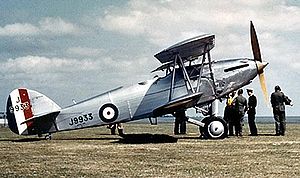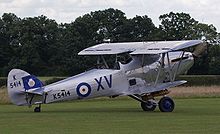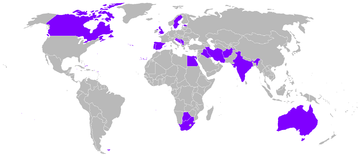Hawker Hart Video - At Old Warden - Takeoff
|
|
Hawker Hart

Picture - Hawker Hart
Role: Light bomber
Manufacturer: Hawker Aircraft Limited
Designed by: Sydney Camm
First flight: June 1928
Introduced: 1930
Primary user: Royal Air Force
Variants: Hawker Hind
Hawker Hector
The Hawker Hart was a British two-seater biplane light bomber of the Royal Air Force (RAF), which had a prominent role during the RAF's inter-war period. The Hart was designed during the 1920s by Sydney Camm and built by Hawker Aircraft. It spawned several variants, including a naval version.
Design and development
In 1926, the Air Ministry stated a requirement for a high performance light bomber, and which culminated in the choice of the Hawker Hart over other rivals (Avro Antelope and Fairey Fox) due to it being far cheaper to maintain, a vital aspect to a programme during defence budget constraints that the British armed forces faced during the 1920s.
J9052, the prototype Hart, first flew in June 1928 and entered service with No. 33 Squadron RAF in 1930. Over 900 Harts of all types were built. It became the most widely used light bomber of its time and the design would prove to be a successful one with a number of derivatives, including the Hawker Hind and Hector, being made. There were a number of Hart variants made, though only slight alterations were made. The Hart India was basically a tropicalised version of the aircraft; the Hart Special was another tropicalised version based on the Hawker Audax, a Hart variant, with desert equipment; a specialised Hart Trainer was also designed. Vickers built 114 of the latter model at Weybridge between 1931 and June 1936.
The Hart was armed with a single forward .303 in (7.7 mm) Vickers machine gun and one rear .303 in (7.7 mm) Lewis Gun; the Hart also had a capacity to carry 520 lb (235 kg) of bombs. The Hart had a single 525 hp (390 kW) Rolls-Royce Kestrel IB 12-cylinder V-type engine; a speed of 184 mph (296 km/h) and a range of over 400 mi (640 km). It was faster than most contemporary fighters, an astonishing achievement considering it was a light bomber, and had high manoeuvrability, making the Hart one of the most effective biplane bombers ever produced for the Royal Air Force. In particular, it was faster than the Bristol Bulldog, which had recently entered service as the RAF's front-line fighter. This disparity in performance led the RAF to gradually replace the Bulldog with the Hawker Fury.
Demand for the bomber was such that 164 were built by Vickers-Armstrongs at its Weybridge factory at Brooklands between 1931 and 1936 after that company's submission of a tender, alongside the trainers mentioned above.
Operational history
Harts were deployed to the Middle East during the Abyssinia Crisis of 1935-1936. The Hart saw extensive, and successful, service in the North-West Frontier, British India during the inter-war period. Four Hawker Harts from the Swedish Air Force saw action as dive bombers during the 1939-1940 Winter War as part of a Swedish volunteer squadron, designated F19, fighting on the Finnish side. Though obsolete compared to the United Kingdom's opposition at the start of the Second World War, the Hart continued in service, mainly performing in the communications and training roles until being declared obsolete in 1943.
The Hart proved to be a successful export, seeing service with the Royal Egyptian Air Force, Royal Indian Air Force, South African Air Force, Estonian Air Force, Southern Rhodesia, Sweden (where it was designated B4) and Kingdom of Yugoslavia.
Swedish Air Force general Bjorn Bjuggren wrote in his memoirs how his squadron in the mid 1930s developed dive-bombing techniques for their B4s. (He actually claims that he got this idea from watching a Hollywood movie with divebombers.) When the Hawker engineers found out, they issued a formal objection, saying that the plane had not been designed for that purpose; however, Swedish pilots proved that the aircraft was up to that task and dispelled their concern.
Variants
Hart
Estonian Hart Export version for Estonia, equipped with an interchangeable wheel or float undercarriage; eight built. Hart I Two-seat light bomber aircraft. Hart Communications Two-seat unarmed communications aircraft for the RAF, a small number were used by No. 23 squadron RAF; nine built. Hart SEDB Two-seat single-engined light bomber aircraft for the RAF, powered by a 525-hp Rolls-Royce Kestrel IB, or a 510-hp Kestrel X (DR) piston engine. Hart Trainer Two-seat dual-control trainer aircraft. Hart Trainer (Interim) Hart light bombers converted into training aircraft. Hart Two-Seat Fighter Two-seat fighter version for the RAF, a small number were used by No. 23 squadron RAF. Later redesignated as the Hart Fighter; six built. Hart (India) Tropicalised version for the RAF, used by RAF in the North West Frontier of India. Hart (Special) Tropicalised version for the RAF, used by the RAF in the Middle East. Swedish Hart Hawker-built pattern aircraft, powered by a Bristol Pegasus IM2 radial piston engine; four built and exported to Sweden. Swedish Hart Swedish-built aircraft, powered by a Swedish-built NOHAB Bristol Pegasus IU2 radial piston engine; 42 built under licence in Sweden.
Audax
The Hawker Audax was a Hart variant, designed for the army co-operation role, seeing much service in the British Empire. The first Audax flew in late 1931, and eventually, over 700 Audaxes were produced (including export). The Audax was very similar to the Hart, though had some modifications, including a hook to pick up messages. The Audax was armed with a single .303 in (7.7 mm) Lewis light machine gun and a .303 in (7.7 mm) Vickers machine gun. The Audax was powered by a version of the Kestrel engine and had a maximum speed of 170 mph (274 km/h). A number of variants of the Audax were produced, including the Audax India, a tropicalised version of the Audax for service in India; the Audax Singapore for service there.
The Audax saw service with other air forces, including the Royal Canadian Air Force, the Royal Indian Air Force, the South African Air Force, the Royal Egyptian Air Force, the Royal Iraqi Air Force, the Imperial Iranian Air Force, the Straits Settlements, and the Southern Rhodesian Air Force. The Audax saw limited service during the Second World War, seeing service in Africa on the Kenya-Abyssinia border, the latter of which had been occupied by Italy. The Audax also saw service in Iraq, at RAF Habbaniya, west of Baghdad, after the uprising there, the Anglo-Iraqi War; influenced by Axis forces, but the Audax ended its service by 1945. A derivative of the Audax, the Hawker Hartebees, a light bomber, was built for the South African Air Force with modifications made from the Audax. Sixty-five of these aircraft were built, the majority in South Africa. The aircraft saw action in East Africa during clashes against Italy who occupied Abyssinia.
A.V.Roe and Co. built 287 Audaxes as part of the RAF expansion scheme during 1935-7. These did not warrant an Avro type number, but between 1937-8 Avro built 24 modernised Audaxes for the Egyptian government, powered by 750 hp (560 kW) Armstrong Siddeley Panther VIA radials. Acknowledging the amount of redesign work done, these were designated the Avro Type 674.
Audax I Two-seat army co-operation aircraft for the RAF, powered by a 530-hp (395-kW) Rolls-Royce Kestrel IB, or 580-hp Kestrel X piston engine. Audax (India) Tropicalised version for the RAF, used by the RAF in India. Audax (Singapore) Tropicalised version for the RAF, powered by a Rolls-Royce Kestrel V piston engine, used by the RAF in Singapore and British Malaya. Canadian Audax Modified version of the Audax I for the RCAF; one built for Canada. Egyptian Audax Six aircraft fitted with the 750-hp Armstrong Siddeley Panther radial piston engine, plus 18 aircraft fitted with the Panther X radial piston engine; 34 built for Egypt. Iraqi Audax 24 aircraft fitted with the Bristol Pegasus IIM2 radial piston engine, plus ten aircraft fitted with the Pegasus VIP8 radial piston engine; 34 built for Iraq. Persian Audax 30 aircraft fitted with the Pratt & Whitney Hornet S2B radial piston engine, plus 26 aircraft fitted with the Bristol Pegasus IIM or IIM2 radial piston engine; 56 built for Persia. Hartbees Hawker built pattern aircraft; four built and exported to South Africa. Hartebees I Two-seat general-purpose, ground-surpport aircraft for the South African Air Force, powered by a 608-hp (453-kW) Rolls-Royce Kestrel VFP piston engine; 65 aircraft built under licence in South Africa.
Demon
The Hawker Demon was a fighter variant of the Hart light bomber, and which the Air Ministry stated should be able to intercept the Hart. The intention was for the Demon to just be an interim fighter until the advanced Hawker Fury entered service. Over 200 Hawker Demons were built for the RAF. The Demon were powered by varying types of the Kestrel engine. It had an armament of a single rear .303 in (7.7 mm) Lewis Gun with two .303 in (7.7 mm) Vickers machine guns in the nose. Large numbers of the type were fitted with an hydraulically powered turret in the rear, which had been tested on the Hawker Hart. The Demon was also sold to the Royal Australian Air Force. It saw only brief second-line operations during the Second World War.
Production of the Demon was by Hawker and by Boulton Paul Aircraft, Norwich.
Hart Two-Seat Fighter Two-seat fighter version of the Hart for the RAF. Later redesignated as the Hart Fighter. Demon I Two-seat fighter aircraft for the RAF. Australian Demon I Two-seat fighter aircraft for the RAAF, similar to RAF version but fitted with a 600 hp (447 kW) Rolls Royce Kestrel V engine; 64 built. Australian Demon II Two-seat training version for the RAAF, standard Demon fitted with dual controls. Turret Demon Two-seat fighter version, fitted with a Frazer-Nash gun turret in the rear cockpit.
Hardy
The Hawker Hardy was general-purpose variant of the Hawker Hart tropicalised to meet Air Ministry Specification G.23/33 as a Wapiti replacement in Iraq. The prototype was a production Hart which was modified with a modified radiator, a message pick-up hook, water containers and a desert survival kit. The prototype first flew on 7 September 1934, and the first production aircraft were delivered to 30 Squadron in January 1935. The Hardy saw some service during the Second World War, in Africa and the Middle East; the Hardys performing a number of operations against Italian-occupied Abyssinia as well as other areas of Africa. The Hardy also saw service with Southern Rhodesia. The last operational sortie by a Hardy was on the 9 May 1941 and most of the survivors were scrapped, although some continued in service as communications aircraft. On 14 May 1941, the Belgian Colonial authorities obtained a Hawker Hardy from the South African Air Force. Painted in Belgian colours, the machine was used for observation missions, but unfortunately overturned while landing at Gambela airfield on 26 May 1941, effectively writing off the machine.
Hardy I Two-seat general-purpose aircraft for the RAF, 47 built excluding one prototype modified from a Hart.
Hind

Picture - Hawker Hind, flying example in Shuttleworth Collection
The Hawker Hind was a derivative of the Hart and was intended to replace it. The Hawker Hector was a variant of the Hind and was used in the army co-operation role. It saw only limited service during the Second World War with the Royal Air Force. Hectors were also sold to Ireland.
Osprey
The Hawker Osprey was the navalised carrier-borne version of the Hart, performing in the fighter and reconnaissance roles. The Osprey had a single Rolls-Royce Kestrel II engine, and had a max speed of 168 mph (270 km/h). Its armament consisted of a single forward .303 in (7.7 mm) Vickers machine gun and one .303 in (7.7 mm) Lewis gun. The Osprey joined the Fleet Air Arm (FAA) in 1932, with just over 100 being built, and ended its career in 1944 after serving as a trainer for FAA pilots during her career in the Second World War. The Osprey was also sold to the Swedish Navy being used on the seaplane cruiser HMS Gotland, which carried six Ospreys. Ospreys were also sold to the air forces of Portugal and Spain.
Osprey I Two-seat fleet spotter and reconnaissance aircraft, power by a 630 hp (470 kW) Rolls-Royce Kestrel IIMS inline piston engine; 37 built. Osprey II Two-seat fleet spotter and reconnaissance aircraft, powered by a 630-hp (470-kW) Rolls-Royce Kestrel IIMS piston engine, equipped with redesigned floats; 14 built. Osprey III Tho-seat fleet spotter and reconnaissance aircraft, powered by a 630-hp (470-kW) Rolls-Royce Kestrel IIMS piston engine, equipped with a dinghy stowed away in the starboard upper wing; 26 built. Osprey IV Two-seat fleet spotter and reconnaissance aircraft, powered by a Rolls-Royce Kestrel V inline piston engine. Portuguese Osprey One aircraft fitted with a Rolls-Royce Kestrel IIMS piston engine; one built for Portugal. Spanish Osprey One aircraft fitted with a Hispano-Suiza 12Xbrs engine; one built for Spain. Swedish Osprey Four aircraft fitted with a Swedish-built NOHAB Bristol Mercury radial piston engine; four built for Sweden.
Operators

Picture - Hart, Audax, Demon, and Osprey operators
Hawker Hart
Afghanistan
Canada
Egypt
Estonia
British India
South Africa
Southern Rhodesia
Sweden
United Kingdom
Kingdom of Yugoslavia
Hawker Audax
British India
Canada
Egypt
Iraq
Persia
Southern Rhodesia
Straits Settlements
United Kingdom
Hawker Demon
Australia
United Kingdom
Hawker Hardy
United Kingdom
Southern Rhodesia
Belgium (1 aircraft, ex-RAF K4316)
Hawker Hartebees
South Africa
Hawker Osprey
Portugal
Spanish Republic
Sweden
United Kingdom
Specifications (Hart (Kestrel IB powered day bomber))
Data from The British Bomber since 1914
General characteristics
Crew: 2
Length: 29 ft 4 in (8.94 m)
Wingspan: 37 ft 3 in (11.36 m)
Height: 10 ft 5 in (3.18 m)
Wing area: 349.5 ft² (32.5 m²)
Empty weight: 2,530 lb (1,150 kg)
Max takeoff weight: 4,596 lb (2,089 kg)
Powerplant: 1x— Rolls-Royce Kestrel IB water-cooled V12 engine, 510 hp (380 kW)
Performance
Maximum speed: 161 kn (185 mph, 298 km/h) at 13,000 ft
Stall speed: 39 kn (45 mph, 72 km/h)
Range: 374 nmi (430 mi, 692 km)
Service ceiling: 22,800 ft (6,950 m)
Wing loading: 13.2 lb/ft² (64.3 kg/m²)
Power/mass: 0.11 hp/lb (0.182 kW/kg)
Climb to 10,000 ft 8 minutes, 30 seconds
Armament
Guns: 1 x— synchronised forward firing .303 in (7.7 mm) Vickers machine gun, 1 x— .303 in (7.7 mm) Lewis Gun on Scarff ring in rear cockpit.
Bombs: Up to 500 lb (227 kg) bombs under wings.
Bibliography
Crawford, Alex. Hawker Hart Family. Redbourn, Hertfordshire, UK: Mushroom Model Publications Ltd., 2008. ISBN 83-89450-62-3.
Goulding, James and Robert Jones. Gladiator, Gauntlet, Fury, Demon (Camouflage & Markings: RAF Fighter Command Northern Europe, 1936 to 1945). London: Ducimus Books Ltd., 1971.
Hannah, Donald. Hawker FlyPast Reference Library. Stamford, Lincolnshire, UK: Key Publishing Ltd., 1982. ISBN 0-946219-01-X.
James, Derek N. Hawker, an Aircraft Album No. 5. New York: Arco Publishing Company, 1973. ISBN 0-668-02699-5 (first published in the UK by Ian Allan in 1972).
Mason, Francis K. The British Bomber Since 1914. London: Putnam Aeronautical Books, 1994. ISBN 0-85177-861-5.
Mason, Francis K. Hawker Aircraft since 1920. London: Putnam Aeronautical Books, 1991. ISBN 0-85177-839-9.
Mason, Francis K. The Hawker Audax & Hardy (Aircraft in Profile nr. 140). Leatherhead, Surrey, UK: Profile Publications Ltd., 1966.
Rimell, Raymond Laurence. The Hart Family - Hawker Hart & Derivatives (Aeroguide Classics Number 5). Chipping Ongar, Essex, UK: Linewrights Ltd., 1989. ISBN 0-946958-34-3.
Living Warbirds: The best warbirds DVD series.
Source: WikiPedia